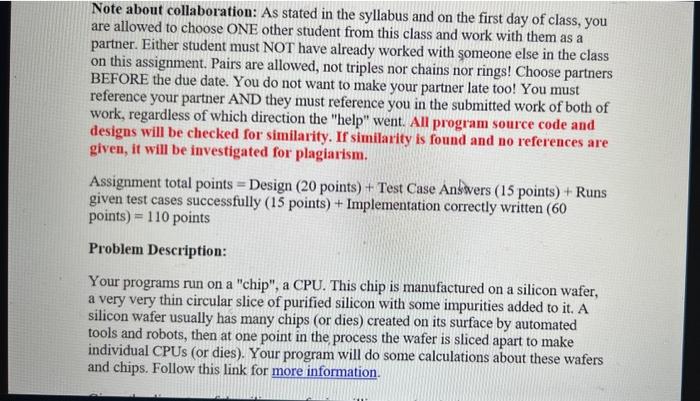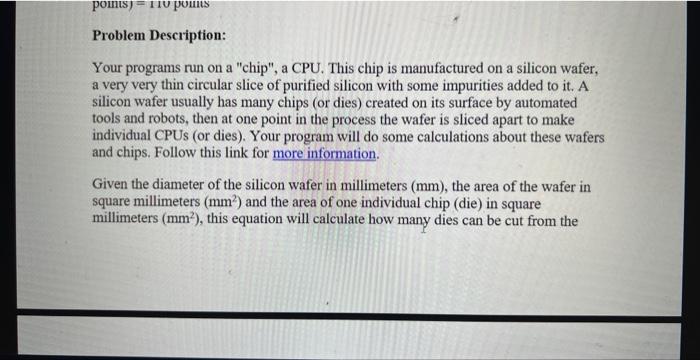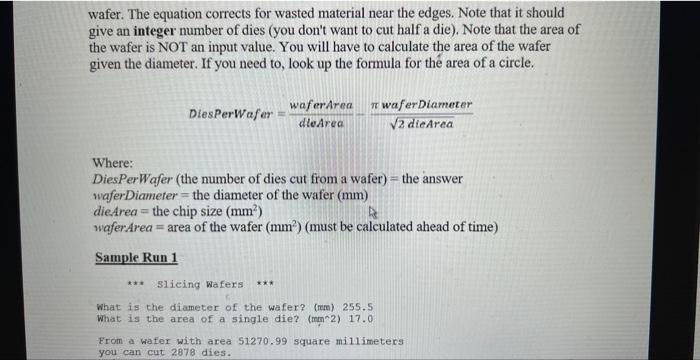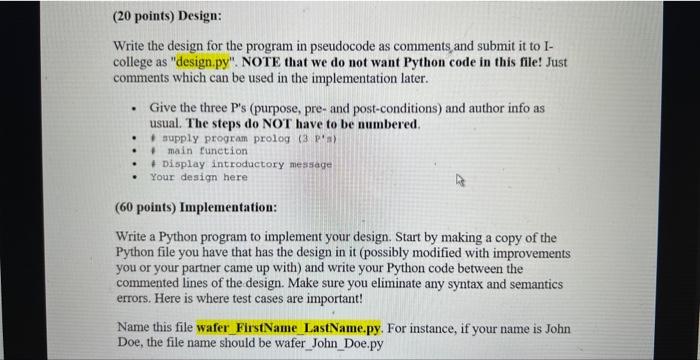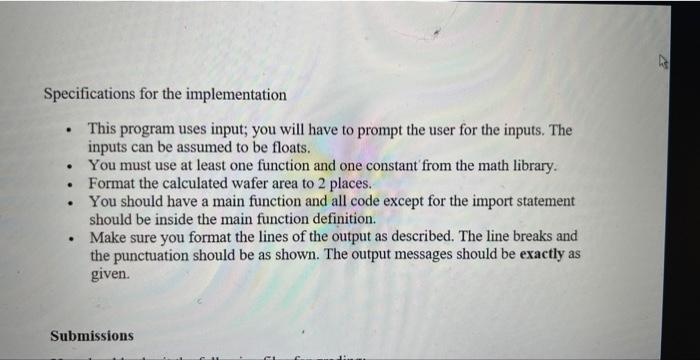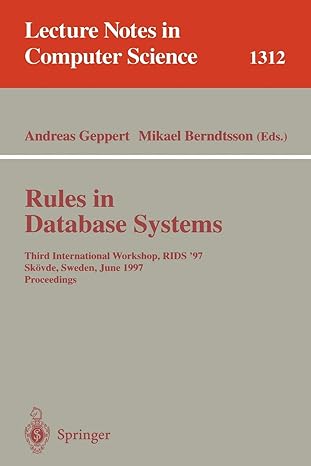are allowed to choose ONE other student from this class and work with them as a partner. Either student must NOT have already worked with someone else in the class on this assignment. Pairs are allowed, not triples nor chains nor rings! Choose partners BEFORE the due date. You do not want to make your partner late too! You must reference your partner AND they must reference you in the submitted work of both of work, regardless of which direction the "help" went. All program source code and designs will be checked for similarity. If similarity is found and no references are given, it will be investigated for plagiarism. Assignment total points = Design (20 points )+ Test Case Answers (15 points )+ Runs given test cases successfully ( 15 points) + Implementation correctly written (60 points) =110 points Problem Description: Your programs run on a "chip", a CPU. This chip is manufactured on a silicon wafer, a very very thin circular slice of purified silicon with some impurities added to it. A silicon wafer usually has many chips (or dies) created on its surface by automated tools and robots, then at one point in the process the wafer is sliced apart to make individual CPUs (or dies). Your program will do some calculations about these wafers and chips. Follow this link for more information. Problem Description: Your programs run on a "chip", a CPU. This chip is manufactured on a silicon wafer, a very very thin circular slice of purified silicon with some impurities added to it. A silicon wafer usually has many chips (or dies) created on its surface by automated tools and robots, then at one point in the process the wafer is sliced apart to make individual CPUs (or dies). Your program will do some calculations about these wafers and chips. Follow this link for more information. Given the diameter of the silicon wafer in millimeters (mm), the area of the wafer in square millimeters ( mm2 ) and the area of one individual chip (die) in square millimeters (mm2), this equation will calculate how many dies can be cut from the wafer. The equation corrects for wasted material near the edges. Note that it should give an integer number of dies (you don't want to cut half a die). Note that the area of the wafer is NOT an input value. You will have to calculate the area of the wafer given the diameter. If you need to, look up the formula for the area of a circle. DiesPerWafer=dleAreawaferArea2dieAreawaferDiameter Where: DiesPerWafer (the number of dies cut from a wafer) = the answer waferDiameter = the diameter of the wafer (mm) dieArea = the chip size (mm2) waferArea = area of the wafer (mm2) (must be calculated ahead of time) Sample Run 1 What is the diameter of the wafer? (mm) 255.5 What is the area of a single die? (mmn2)17.0 From a wafer with area 51270.99 square milimeters you can cut 2878 dies. waferArea = area of the wafer (mm2) (must be calculated ahead of time) Sample Run 1 ** Slicing Wafers ** What is the diameter of the wafer? (ma) 255.5 What is the area of a single die? (man-2) 17.0 From a wafer with area 51270.99 square millineters you can cut 2878 dies. This does not take into account defective dies, alignment markings and teat sites on the wafer's surface. Sample Run 2 What is the diameter of the wafer? ( mm)400. What is the area of a single die? (mm2)25.0 Fron a wafer with area 125663.71 square millimeters you can cut 4848 dies. This does not take into account defective dies, alignment markings and test gites on the wafer'g surface. Test Plan ( 30 points) Part of our grading process will be to run your program with these cases. Submit screenshots to demonstrate results for A., B., and C. No points would be given if there are no screenshots of the test cases. To get full credit, your program must produce the right results for all test cases below and you must provide screenshots. Test cases are worth 5 points each. (20 points) Design: Write the design for the program in pseudocode as comments and submit it to Icollege as "design.py". NOTE that we do not want Python code in this file! Just Write the design for the program in pseudocode as comments and submit it to Icollege as "design.py". NOTE that we do not want Python code in this file! Just comments which can be used in the implementation later. - Give the three P's (purpose, pre- and post-conditions) and author info as usual. The steps do NOT have to be numbered. - I supply program prolog (3 p'a) - I main function - I Display introdactory message - Your design here (60 points) Implementation: Write a Python program to implement your design. Start by making a copy of the Python file you have that has the design in it (possibly modified with improvements you or your partner came up with) and write your Python code between the commented lines of the design. Make sure you eliminate any syntax and semantics errors. Here is where test cases are important! Name this file wafer FirstName LastName.py. For instance, if your name is John Doe, the file name should be wafer_John_Doe.py Specifications for the implementation - This program uses input; you will have to prompt the user for the inputs. The inputs can be assumed to be floats. - You must use at least one function and one constant from the math library. - Format the calculated wafer area to 2 places. - You should have a main function and all code except for the import statement should be inside the main function definition. - Make sure you format the lines of the output as described. The line breaks and the punctuation should be as shown. The output messages should be exactly as given
